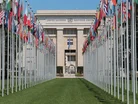Why the UN is Urging Stronger Action Against Scope 3

The latest UN Nationally Determined Contributions (NDC) Synthesis Report paints a stark picture for global climate action.
Released just ahead of the COP29 climate summit, it emphasises that despite national commitments, current efforts fall far short of what is needed to cap global warming at 1.5ºC.
Instead, global greenhouse gas (GHG) emissions are on track to reach new highs, putting the planet on a trajectory towards potentially catastrophic outcomes.
Scope 3 emissions: The unseen giant
One of the most pressing issues highlighted in the report is the impact of Scope 3 emissions.
According to UN data, these emissions typically make up the bulk of a nation or company’s carbon footprint - sometimes accounting for more than 90% of total emissions.
Addressing Scope 3 emissions is challenging precisely because they are indirect and spread out across numerous sources. This makes it hard for even the most well-meaning policies to have a comprehensive effect.
UN Climate Change Executive Secretary, Simon Stiell, stresses: “The report’s findings are stark but not surprising – current national climate plans fall miles short of what’s needed to stop global heating from crippling every economy and wrecking billions of lives and livelihoods across every country.”
Countries report their domestic efforts through NDCs, which act as their roadmaps for reducing GHG emissions.
However, the UN’s analysis shows that while commitments are being made, they are not ambitious enough to drive down Scope 3 emissions effectively.
These emissions remain elusive, embedded in the complexities of global supply chains and economic interdependencies.
The race against time
The report indicates that unless emissions are slashed by 43% by 2030 compared to 2019 levels, the world will not meet the goals set out in the Paris Agreement.
Despite existing plans, current projections suggest that GHG emissions will reach around 51.5 giga-tonnes of CO2 by 2030. This level of emissions keeps the world firmly on a path towards a peak global temperature of 2.8°C - far beyond the agreed targets.
“Either leaders bridge the emissions gap, or we plunge headlong into climate disaster – with the poorest and most vulnerable suffering the most," asserted António Guterres, Secretary General of the United Nations.
"Affordable, existing technologies can achieve the emissions reductions we need to meet the 1.5 degree limit.”
What makes tackling Scope 3 emissions particularly complicated is the uneven capability of nations and industries to act. While some developed countries have the resources and technology to transition to greener operations, many developing nations and small businesses struggle due to limited funding and access to necessary infrastructure.
The report notes that a significant share of global emissions reductions must come from addressing these Scope 3 sources if the world is to stay on track.
Can we turn the tide?
To make real progress, the UN emphasises a collective approach that goes beyond isolated national strategies.
Coordinated international support is essential to assist developing economies and industries shift their practices.
Simon calls for “a new age of acceleration, with much bolder new national climate plans from every country due next year.”
At the heart of tackling Scope 3 emissions is the need for cross-border collaboration. Countries must commit to sharing technology, expertise and funding mechanisms that can enable global supply chains to align with sustainability targets.
The need for this kind of approach was echoed in the report’s findings, which showed only slight reductions in projected GHG levels despite incremental updates to NDCs.
The UN also points to the potential of new technologies to play a part in addressing historical and ongoing emissions. Direct air capture (DAC) and carbon capture utilisation and storage (CCUS) are highlighted as tools that can mitigate existing atmospheric carbon.
These solutions, along with renewable energy advancements, offer hope but require significant investment and policy support to scale effectively.
The UN report makes it clear: tackling emissions, particularly Scope 3, requires global ambition, unity and decisive action.
With the world watching, leaders at COP29 will need to respond to this call to action or risk further entrenching the climate crisis.
Receive the next edition of Scope 3 Magazine by signing up for its newsletter.
As part of this portfolio, make sure you check out Procurement Magazine and also sign up to our global conference series - Procurement & Supply Chain LIVE.
Scope 3 Magazine is a BizClik brand.
- Maersk Sustainability Reporting: Navigating Scope 3Transportation & Logistics
- SHEIN’s Scope 3 Emissions: Fast Fashion’s Carbon BurdenCircular Economy
- Tackling Super Bowl LIX's Scope 3 Emissions ChallengeScope 1 2 and 3
- NetApp’s SBTi Validation Marks Sustainability MilestoneScope 1 2 and 3
Featured Articles
Estonia, Latvia and Lithuania join the European grid, cutting ties with Russian energy, a move that boosts regional security and sustainability
TÜV SÜD: New battery regulations bring Scope 3 hurdles, requiring sustainable sourcing, digital traceability and design changes increasing compliance
Nissan is scaling up its use of green steel, reducing CO2 emissions in its supply chain as part of its goal to achieve carbon neutrality by 2050

